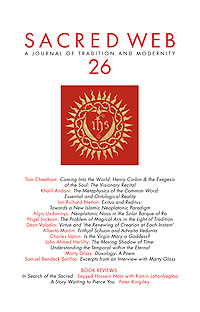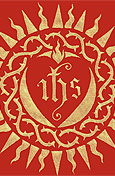Sacred Web 26
Editorial:
The Black Mole on the Cheek of the Beloved:
The Problem of Metaphysical Ambiguity
by M. Ali Lakhani
When the poet, Hafiz, extravagantly offered to barter away Bokhara and Samarkand—the jewels of Tamerlane's empire—for the "Black Mole" on the cheek of his Beloved, the emperor was reportedly enraged. But what did the "Black Mole" signify for the poet-dervish, and how did this differ from its significance for the emperor? The editorial explores the metaphysical ambiguity underlying these differing perceptions, and the touches on the implications for tradition and modernity. Read more ...
Coming Into the World:
Henry Corbin & the Exegesis of the Soul
Part Two: The Visionary Recital
by Tom Cheetham
This essay—the second of two parts—continues a reading of Henry Corbin's "Cyclical Time in Mazdaism and Isma'ilism" and Avicenna and the Visionary Recital. The first part of Cheetham's essay appeared in volume 25 of Sacred Web, and focused on Corbin's view of cyclical time. The second part focuses on the concept of taw'il (or hermeneutics) and on the phenomenological and hermeneutic vision (the rendering of the Presence of transcendent reality through sacred dramaturgy and angelology) that constitutes the pluralistic foundation of Corbin's work.
The Metaphysics of the Common Word:
A Dialogue of Eckhartian and Isma'ili Gnosis
Part One: Essential and Ontological Reality
by Khalil Andani
This essay—the first of two parts—presents a comparative dialogue between the Trinitarian metaphysics of Christianity as taught by Meister Eckhart and the metaphysics of Islam as elucidated in Shi'a Isma'ili theosophy. This important study, which we believe to be the first of its kind, compares the three Persons of the Christian Trinity with the three highest hypostases of Isma'ili gnosis. In this first installment, the author puts forth the premises for a metaphysical dialogue and outlines the correspondence between the degrees of Beyond-Being and Being as described by Meister Eckhart and the Isma'ili theosophers. This is followed by a detailed comparison of the Eckhartian notion of the Godhead (Gottheit) and the Isma'ili concept of the Divine Essence or the Originator (al-Mubdi) as well as their respective apophatic discourses on the nature of the Ultimate Reality. The first part concludes with a comparison of Eckhart's concept of the Father and the Isma'ili concept of the Divine Command (Amr) in light of the concept of Pure Being. The second installment, which will continue the metaphysical and hypostatic comparisons, is to be published in volume 27 of Sacred Web.
Exitus and Reditus:
Towards a New Islamic Neoplatonic Paradigm
by Ian Richard Netton
Classical Neoplatonism stressed the concepts of outflow or emanation from The One and return to The One. In Islam all things are created by Allah and all things will return to him. This article stresses these key themes as it examines, in a highly interdisciplinary fashion, the realms of diaspora, exile, alienation, longing and loss in such authors as Homer, Plato, al-Mas'udi, the Brethren of Purity (Ikhwan al-Safa'), Shakespeare and Ibsen as they journey in their writings on a Return which for the Muslim is the Paradise Garden of the Blessed.
Neoplatonic Nous in the Solar Barque of Ra:
Problems of Metaphysical Reading
by Algis Uzdavinys
One of the problems of interpretation is the question of the range of possible meanings that any text permits. In this rewarding essay—his last submission to this journal before his untimely death in July 2010—Dr. Uzdavinys proposes and defends a theory of metaphysical interpretation between disparate texts, and applies his theory to illuminate metaphysical correspondences between ancient Egyptian solar mythologies and Neoplatonic doctrines of the Nous, expounding on their theurgic implications.
Whisperings from a Babylonian Well:
The Problem of Magical Arts in the Light of Tradition
by Nigel Jackson
This essay explores the metaphysical significance of anatropic symbolism in Islamic, Platonist and Judaeo-Christian traditions as an entry-point for considerations bearing upon the proliferation of pseudo-spirituality, occultism, sorcery and pseudo-traditions in the modern epoch comprehended as symptomatic manifestations characterizing the final phase of the Kali Yuga.
Virtue and 'the Renewing of Creation at Each Instant': A Reminder
by Deon Valodia
This meditation, presented by the author as 'A Reminder', traces the classic contours of metaphysical praxis. Employing the metaphor of Light and darkness, the author stresses the importance of discernment and self-illumination—of the necessity to discern between higher Self and lower ego, between Reality and illusion—and of the antidote to egoic ossification and forgetfulness through continually renewed virtue and prayer.
Frithjof Schuon and Advaita Vedanta
by Alberto Martin
The aim of this essay is to contrast Schuon's metaphysical system with that Shankara's Advaita Vendanta. Adopting the perspective of a hypothetical Vedantin conversant with Schuon's writings, the author outlines real or apparent differences between the two systems in areas such as modes of realization, the problem of the ego, and the power or "illusion" of Maya, while also noting convergences between the two. The essay concludes with some reflections or "speculations" concerning possible reasons for these differences.
Is the Virgin Mary a Goddess?
by Charles Upton
This short essay addresses the issue of 'in what way, or to what degree, the Virgin Mary might actually participate in Divinity'. The author explains, with reference to doctrinal correspondences in Advaita Vedanta and in Sufi Islam, how the Virgin represents the perfection of the human receptivity to the Divine Spirit, and cautions against the speculative and heterodox tendencies to divinize this aspect of Reality. The author concludes with a poem titled "Maryam".
The Moving Shadow of Time:
Understanding the Temporal within the Eternal
by John Ahmed Herlihy
This meditation on the temporal and the eternal considers some of the myths and symbols of Time, reflecting on its significance in terms of what it reveals about us outwardly and inwardly as human beings, of our creaturely status and of our inner purpose. The essay includes a section on the significance of Muslim prayer times, and its revelation of the movement from horizontal time (changing time and sempiternity) to vertical time (the Present 'now" of God's eternity).
Doxology
A Poem by Marty Glass
Read more ...
Tears, Laughter, Compassion and Wisdom in the Kali Yuga:
Marty Glass Interviewed
by Samuel Bendeck Sotillos
Read more ...
Book Reviews:
In Search of the Sacred: A Conversation with
Seyyed Hossein Nasr on His Life and Thought: Seyyed Hossein Nasr with Ramin Jahanbegloo
Reviewed by M. Ali Lakhani
Read more ...
A Story Waiting to Pierce You:
Mongolia, Tibet and the Destiny of the Western World
By Peter Kingsley
Reviewed by Nicolas Leon Ruiz
Read more ...
Letter to the Editor
Some Thoughts on Charles Upton's "The Three Pillars
of Classical Traditionalism/Perennialism"
by Joseph Fitzgerald
Notes on Contributors




